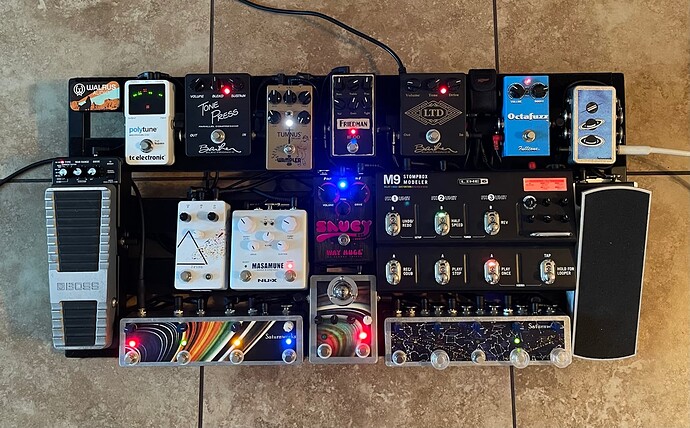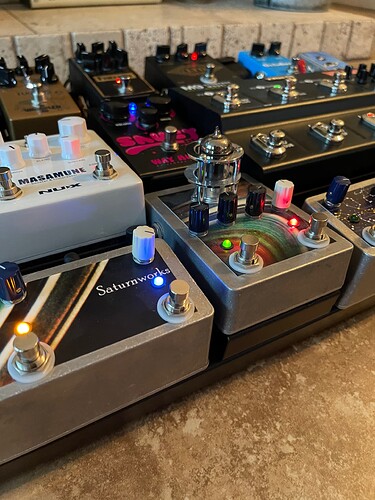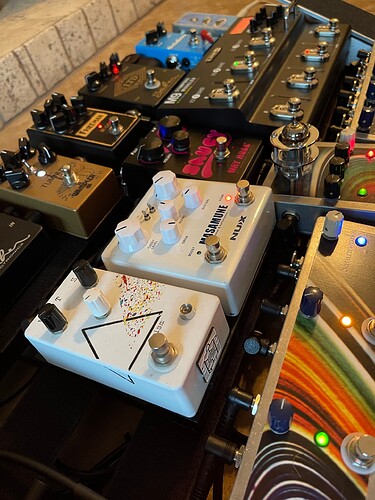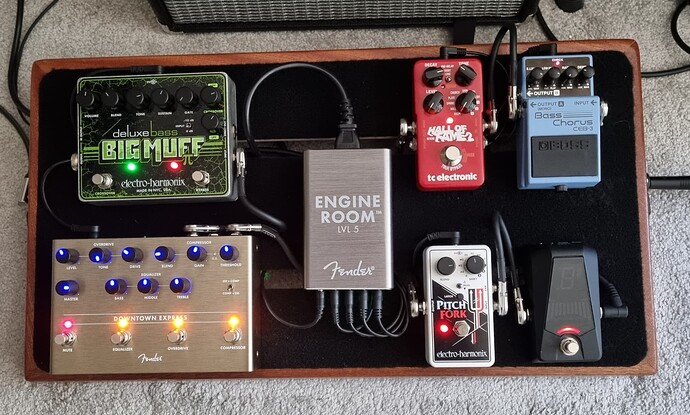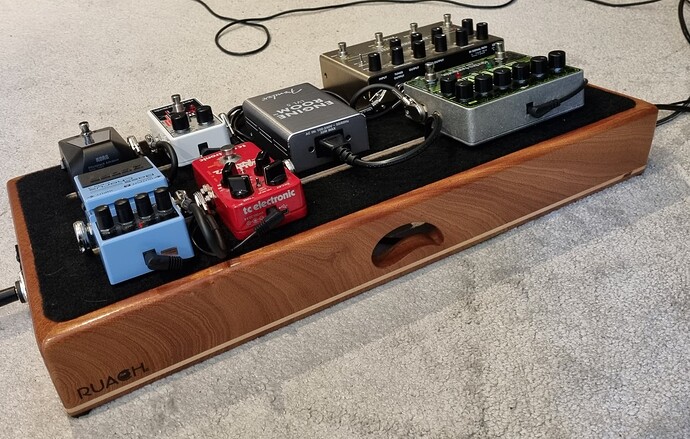Sweet looking setup. We still need a top down shot of all the pedals. 

Here ya go. Pretty simple but I run two channels out of it. One channel I run from the distortion pedal and the other channel is more clean and both go thru the house and our sound guy mixes my sound. I run two channels because it allows me to keep the low end that I loose when I kick in my distortion. I also use IEMs and can mix my own sound with both channels.
Tuner—->compressor—->octave—->MXR DI—-> split channels—-one to house the other to Distortion pedal—-> DI box—-> house.
I want a tone hammer but just don’t have the spare $$$ for it yet.
How do you like that Fender distortion? The DI+ does distortion as well, no?
Yep, +1 to this. I was about to ask about the Fender distortion too.
I love the fender distortion pedal…I can get sooo many tones out of it and it has two channels that I can use individually or together…it’s freaking awesome and well worth the $$ imo. The MXR pedal…it’s just meh in my opinion. Not a fan of its distortion, I like the pedal and some of the things it can do, just not the distortion…but that’s not really what I use it for anyway.
Love the tube preamp - a new one to me, I’m not familiar with Saturnworks.
How do you like the M9?
Love it. Only using it for synths, delays, reverbs and looper.
Their older multi-effects units are so cheap anymore I’m grabbing them when they come up at a good price. Just got an older POD XT live for pennies as a backup but it’s a fun couch and headphone unit that’s a little more versatile than my zoom units or nano board setups.
Yeah I just got a Bass POD Pro for way under $100. Mostly just want it for the amp/cab sims while playing through my monitors. It’s cheaper than most cabsim pedals and a rack unit so it has nice flexible routing options 
the original Bass POD’s (including your Pro) is quite different than the XT’s actually. both are cool, I much prefer the older ones but the XT’s offer a very large pannel of models. (the larger pannel being the X3’s)
Looking super sick Jesse


What the hell is that 2 tiered space station on top of the pedal to the right of the saturnworks
tube guard
Whoa, whoa, whoa. You can’t just give us a picture of this beautiful creature without telling us what it all does and how it’s connected. Inquiring minds need to know the details.
That will be a bit of a lengthy post. Hahaha. I will type it up tomorrow. The short version, is that as much as it’s a complicated pile of noise Lego’s, it’s actually set up somewhat intuitively once you stand in front of it and I give a quick explanation. And it allows you to use as little as you want, or explore the depths of space, time and fuzz!
Sweet. ![]()
![]()
You asked for it. There isn’t really a long story short explanation so I’ll at least try to not make it boring!!
I’ve had a couple of Saturnworks pedals over my last few board iterations. He does some really cool things and I wanted to use more of his stuff on my big rebuild. This is 90% of the way there. It works as I wanted it to. Now I need to solder custom cables for the whole thing and it will be “done”… you catch my drift.
The whole premise of the board was for it to function like a generally logical signal chain should. With freedom to add, subtract, and stack in the same way a normal serial layout would but with most layering pedals attached to a true bypass loop that takes it out of the signal path when it’s not on.
In the top right corner is the patch bay. This is passive and unbuffered.
The guitar plugs into the bottom right jack.
From there it goes to the Tumnus deluxe which is always on and the buffer switch is turned off. I leave it off because there will be fuzz after and they no likey buffers. As a Klon clone of good reputation, it is a clean, beautiful 3 band eq with the gain dialed all the way back.
From there to the Barber tone press. A very light, again always on compression.
Next is the Tonetuga Prism fuzz. White box with the triangle. David Gilmour-esque fuzz pedal. It is within reach to turn on and off without the switcher.
That goes to the input of the Constellation (so named because Of the graphic) switcher on the right. A passive, true bypass 5 loop switcher by Saturnworks. It has power for the LED’s and that’s it. If you look closely there is a blue knob directly above each foot switch. Those are master channel volumes. Each channel has its own volume control so you can set the pedal to perfect and then achieve unity with the blu volume knob. I know right?!
Channel 1 : Fulltone Octafuzz - cleans up beautifully. Hairy beast when fed appropriately.
Channel 2: Barber LTD Drive - Light gain. Edge of breakup.
Channel 3: Way Huge Saucy Box - Medium gain. Since replaced with a Nobels ODR mini
Channel 4: Boss PW-10 (power wah/univibe on the far left side) - so much usefulness and variety. Google it.
Channel 5: Friedman BE-OD - High gain but still cleans up. Plays well with other. Also powered on a sag port of the power supply. Can replicate a Variac on a Marshall tone if you bring it down to 6.5 volts or so.
Out of the Constellation Switcher we go into the NuX Masamune. This is for heavy compression and also has a boost circuit. Lots of variety in the settings for series, parallel, stacking etc. recommended. This is within reach for access to the compression or boost to flavor tone. Salt and pepper.
This feeds back into the patch bay back at the top right. Into the second port from the bottom. Left side. The reason for this position of the patch bay was intentional. Next in line currently is the volume pedal. Being positioned post drive that means I get full gain structure as I volume swell in, instead of gain increasing with volume. Controlling how much mud I throw into space. It also allows me to audition pedals off board by simply pulling one cable and patching in. This means I’m late in the drive signal chain or early in the modulation and won’t be out of place too far to test.
The tuner runs out of the volume pedal and is always on.
Out of the patch bay again and now we go into the Ring graphic switcher on the left. This I had custom made by Saturnworks. It has the same volume control on each channel, however that’s where the similarities stop. An over complicated a/b control of sorts. With more.
The first switch is a true bypass switch. The white knob is actually a dry blend control. All gain and compression up to this point counts as “dry” signal. This will be a stand alone parallel signal.
Loop 1: (switch 2) this is the Line 6 M9. Synths. Delays. Reverbs. Any and all modulation. Looper. And all modulations respond universally to tap tempo control. Crazy versatile. M9 stays within reach for live preset recall or patch changes. This is a second parallel signal.
Loop 2: (switch 3) The Saturnworks Dark Matter tube preamp and the centerpiece for the space ship. An actual tube preamp. Also has a boost circuit. Both circuits utilize the tube together or independently. Again in its own loop with a master volume. If I’m playing into the front of an amp, I can just turn this loop off. If playing direct I can get real tube saturation on my board. This is a third parallel signal.
Loop 3: (switch 4) when playing with drummers or guitar players who never soundcheck at get-down volumes. Sometimes I wish I had a few extra db without changing gain structure or compression. I had this made with a boost circuit at the tail end of everything just to kick it up a couple db in case I need to be higher in the mix at a big moment.
And it’s still mono!! Three parallel signals:
Drive and compression
M9 modulation
Saturnworks tube preamp
You could turn lots off and still have great, volume knob responsive, dynamic playability, heavy layered drives on command, or go down the rabbit hole of options and alter space and time.
Here is my latest pedal board. I’ve kept the power unit on top as its too nice to hide away underneath. Korg Tuner into the Pitchfork Octave then through the Downtown which has equaliser, overdrive and compressor with the option to compress before or after overdrive. Whilst the Downtown gives you decent distortion its has a lot of tone so then put it through the Big Muff as I like the sound and the fact you can blend the clean bass signal, essential for Muse like tone. Then through the Boss Chorus before ending the chain with the Hll of Fame Reverb. Thats probably it for a while although I am tempted by a Fender ABY so I can maximize the pitchforks potential for some Royal Blood type sounds.
Well done.
@Reasonably_Happy That was a great write up. What a very cool board. Would love to hear how that distorted swell sounds.
I will work on that sir!!

